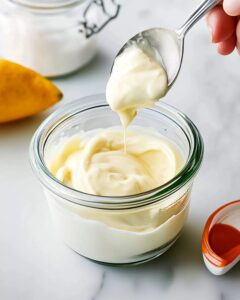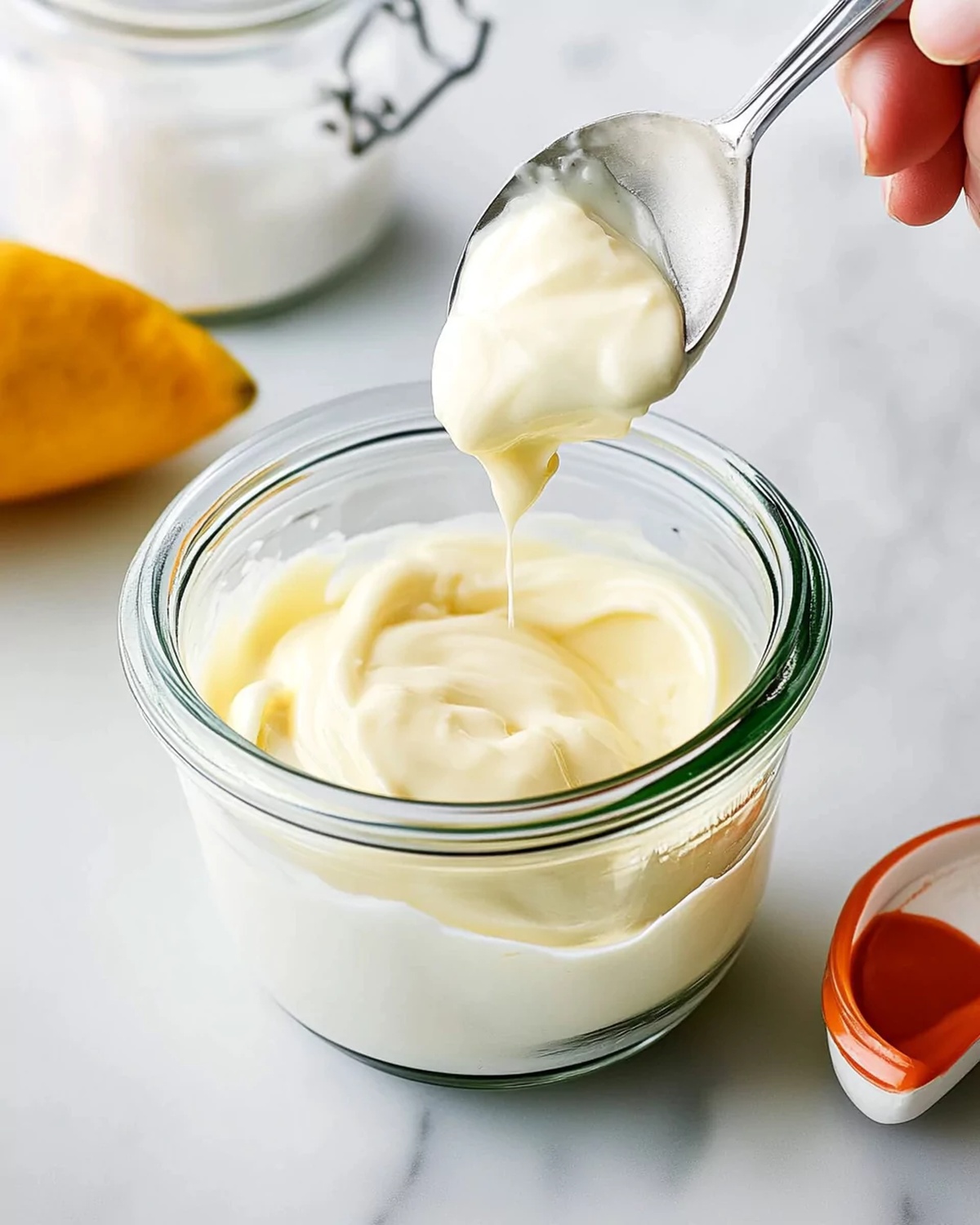Easy Homemade Mayonnaise Recipe: Creamy Bliss in Every Spoonful
Whipping up a creamy homemade mayonnaise recipe can turn any ordinary meal into a culinary adventure.
Kitchen experiments often surprise us with incredible results.
Smooth, silky, and packed with fresh ingredients, this condiment beats store-bought versions hands down.
No complicated techniques stand between you and delicious success.
Simple whisking creates magic in mere minutes.
Professional chefs might guard their secrets, but making mayo is actually straightforward.
You can master this classic sauce with confidence and flair.
Spread, dip, or drizzle – your homemade mayo awaits a delectable debut.
How To Whip Up Easy Homemade Mayonnaise
Step 1: Prepare Blending Ingredients
Gather an egg, fresh lemon juice, white vinegar, Dijon mustard, and salt in the immersion blender jar. Select a neutral-flavored oil like avocado or light olive oil for a smooth, delicate taste.
Step 2: Layer Ingredients Carefully
Slowly pour the oil over the other ingredients, allowing it to rest for about one minute. This helps create the perfect emulsion foundation.
Step 3: Start Blending Magic
Position the immersion blender firmly at the bottom of the jar, covering the egg. Activate the blender and hold steady for 10-15 seconds. Watch as the mixture transforms and thickens like culinary alchemy.
Step 4: Create Silky Smooth Texture
Gently move the blender up and down to fully incorporate all ingredients. The mixture will become creamy and light, developing that classic mayonnaise consistency.
Step 5: Store and Chill
Transfer the freshly made mayonnaise to an airtight container. Refrigerate immediately to maintain its perfect texture and flavor.
Helpful Tips For Easy Homemade Mayonnaise
Simple Spins On Easy Homemade Mayonnaise
What To Serve With Easy Homemade Mayonnaise
How To Store Easy Homemade Mayonnaise
Easy Homemade Mayonnaise Questions Answered
Yes, use fresh, high-quality eggs and pasteurized eggs if concerned about raw egg risks. Fresh ingredients and proper blending ensure food safety.
White wine vinegar, apple cider vinegar, or white vinegar work well. Each adds a slightly different flavor profile to your mayonnaise.
Homemade mayonnaise typically stays fresh for 5-7 days when stored in an airtight container in the refrigerator. Always check for any signs of spoilage before using.
Ensure your ingredients are at room temperature, add oil very slowly, and keep the blender steady at the bottom initially. If it doesn’t emulsify, start over with fresh ingredients.
Why Easy Homemade Mayonnaise Is Handy
Easy Homemade Mayonnaise Ingredient List
Base Ingredients:Oil Ingredients:Optional Flavor Enhancers: Print
Easy Homemade Mayonnaise Recipe
- Total Time: 3 minutes
- Yield: 2 1x
Description
Creamy homemade mayonnaise delivers pure culinary magic with just a few simple ingredients. Kitchen wizards can whip up this silky sauce in minutes, elevating sandwiches and salads with rich, tangy perfection you’ll crave.
Ingredients
Main Ingredients:
- 1 whole egg
- 1 cup (240 milliliters) avocado oil (or light-flavored olive oil)
Acid Ingredients:
- 1/2 tablespoon (7.5 milliliters) lemon juice
- 1 teaspoon (5 milliliters) white wine vinegar
Seasoning Ingredients:
- 1/4 teaspoon (1.25 grams) Dijon mustard
- 1/4 teaspoon (1.5 grams) sea salt
Instructions
- Gather fresh ingredients: egg, lemon juice, vinegar, mustard, and salt at room temperature for optimal blending.
- Select a tall, narrow jar that perfectly fits your immersion blender, ensuring precise emulsification.
- Carefully layer the ingredients, pouring oil gently on top and allowing it to rest for 60 seconds to stabilize.
- Position the immersion blender directly at the bottom of the jar, covering the egg completely, creating a seal for initial blending.
- Activate the blender and maintain a stationary position for 10-15 seconds, watching the mixture transform and thicken rapidly.
- Gradually and smoothly lift the blender up and down, integrating all ingredients into a creamy, uniform consistency.
- Check the mayonnaise’s texture, ensuring a smooth, silky appearance without separation.
- Transfer the freshly prepared mayonnaise into a clean, airtight container with a tight-sealing lid.
- Refrigerate immediately, which helps stabilize the emulsion and enhances flavor development.
- Recommended oil choices include mild avocado or light olive oil to maintain a delicate, balanced taste profile.
- Store homemade mayonnaise for up to one week in the refrigerator, always using clean utensils when serving.
Notes
- Opt for room temperature eggs to ensure smooth emulsification and prevent separation.
- Customize flavors by adding herbs like dill, garlic, or chipotle for a unique twist on classic mayonnaise.
- Use pasteurized eggs or egg alternatives if concerned about raw egg safety, such as aquafaba or silken tofu for vegan versions.
- Store homemade mayonnaise in the refrigerator for up to one week, checking for any signs of spoilage before use.
- Prep Time: 2 minutes
- Cook Time: 15 seconds
- Category: Appetizer, Snacks
- Method: Blending
- Cuisine: American
Nutrition
- Serving Size: 2
- Calories: 900 kcal
- Sugar: 0.1 g
- Sodium: 290 mg
- Fat: 100 g
- Saturated Fat: 14 g
- Unsaturated Fat: 86 g
- Trans Fat: 0 g
- Carbohydrates: 0.5 g
- Fiber: 0 g
- Protein: 2.5 g
- Cholesterol: 185 mg


Michael Thompson
Founder & Recipe Developer
Expertise
Education
Cascade Culinary Institute – Bend, OR
ServSafe Food Handler Certification – Portland, OR
Focus: Certified in core food safety and hygiene principles for both home and professional kitchens, with emphasis on ingredient handling, kitchen cleanliness, and safe preparation methods.
Mike’s kitchen journey began with a single goal: to make everyday meals feel like something worth celebrating.
After earning his Certificate in Culinary Arts from Cascade Culinary Institute, he spent years working with local farmers and small kitchens across Oregon, learning the beauty of seasonal, small-batch cooking.
Mike’s approach is simple, cook with what’s fresh, keep it approachable, and always leave room for a little creativity. When he’s not testing yogurt marinades or designing single-serving meals, you’ll find him hiking trails or hunting down the best berries at local markets.